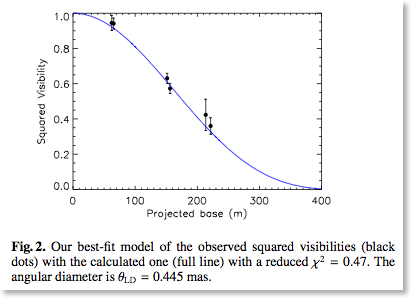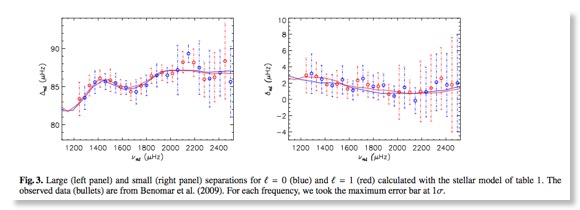L. Bigot, D. Mourard, P. Berio, F. The ́venin, R. Ligi, I. Tallon-Bosc, O. Chesneau, O. Delaa, N. Nardetto, K. Perraut, Ph. Stee, T. Boyajian, P. Morel, B. Pichon, P. Kervella, F. X. Schmider, H. McAlister, T. ten Brummelaar, S. T. Ridgway, J. Sturmann, L. Sturmann, N. Turner, C. Farrington and P. J. Goldfinger 2011, A&A Letter, 534, L3.
The interpretation of stellar pulsations in terms of internal structure depends on the knowledge of the fundamental stellar parameters. Long-base interferometers permit us to determine very accurate stellar radii, which are independent constraints for stellar models that help us to locate the star in the HR diagram. Aims. Using a direct interferometric determination of the angular diameter and advanced three-dimensional (3D) modeling, we derive the radius of the CoRoT target HD49933 and reduce the global stellar parameter space compatible with seismic data.
The VEGA/CHARA spectro-interferometer is used to measure the angular diameter of the star. A 3D radiative hydrody- namical simulation of the surface is performed to compute the limb darkening and derive a reliable diameter from visibility curves. The other fundamental stellar parameters (mass, age, and Teff ) are found by fitting the large and small p-mode frequency separations using a stellar evolution model that includes microscopic diffusion.
We obtain a limb-darkened angular diameter of θLD = 0.445 ± 0.012 mas. With the Hipparcos parallax, we obtain a radius of R = 1.42 ± 0.04 R⊙. The corresponding stellar evolution model that fits both large and small frequency separations has a mass of 1.20 ± 0.08 M⊙ and an age of 2.7 Gy. The atmospheric parameters are Teff = 6640 ± 100 K, log g= 4.21 ± 0.14, and [Fe/H] = −0.38.



